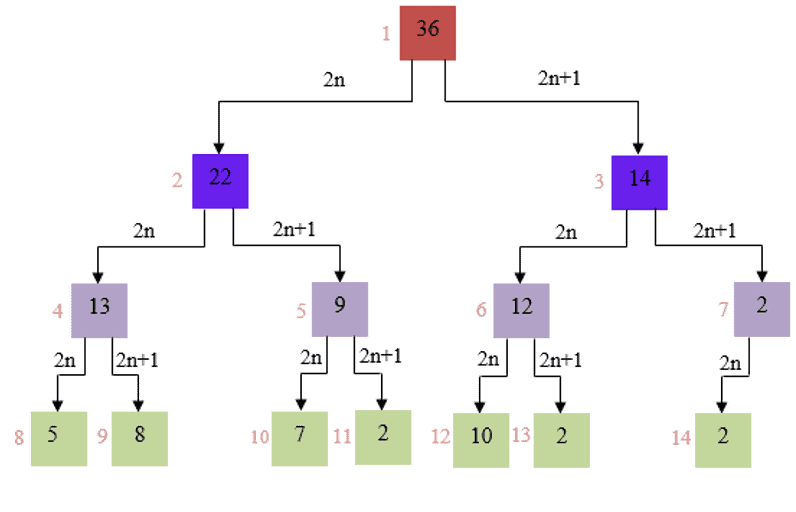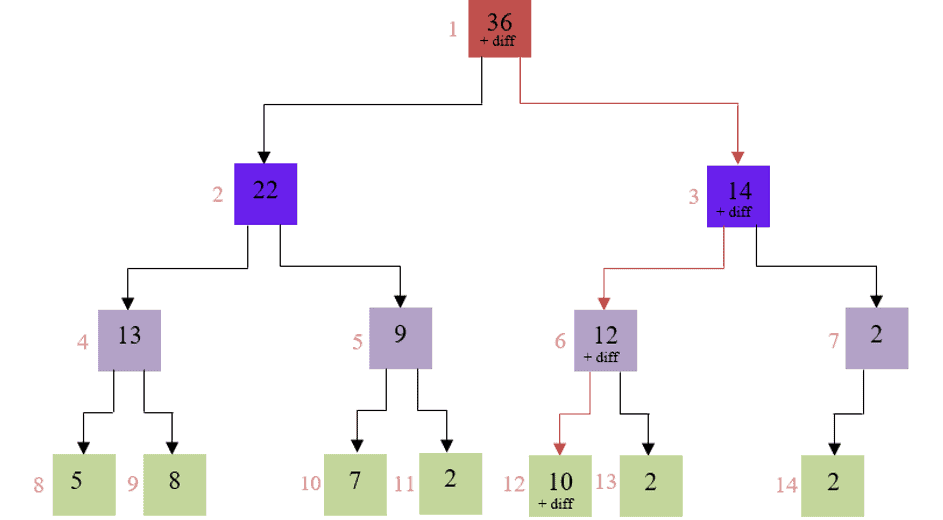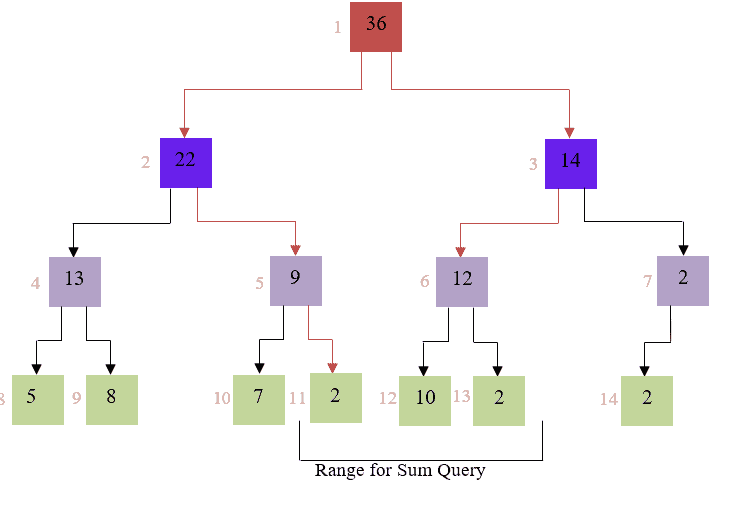1. 概述
线段树(Segment Tree)是一种非常实用的数据结构,广泛应用于需要频繁进行区间查询和更新的场景。它能够以 O(log n) 的时间复杂度完成区间查询(如区间和、最大值、最小值)和单点/区间更新操作。
本文将从线段树的基本概念入手,通过构建、更新和查询的示例,深入理解其工作原理,并介绍其在实际开发中的常见应用场景。
2. 线段树的基本定义
线段树是一种 二叉树结构,用于存储一个数组中各个区间的聚合信息(如和、最大值、最小值等)。每个节点代表一个区间,叶子节点对应数组中的单个元素,内部节点则保存其子节点的合并信息。
例如,如果我们希望频繁查询一个数组的某个子区间的和,线段树就可以将这些区间信息预处理并存储起来,使得每次查询都能在对数时间内完成。
线段树支持以下三种核心操作:
✅ 构建(Build):初始化线段树结构
✅ 更新(Update):修改数组中的某个元素或区间,并更新线段树
✅ 查询(Query):对数组的某个区间进行聚合查询
3. 线段树的工作原理示例
我们以 区间和查询 为例,说明线段树的构建、更新与查询过程。
3.1 构建线段树
假设我们有如下数组:
int[] arr = {5, 8, 7, 2, 10, 2, 2};
我们的目标是构建一个线段树,使得可以快速查询任意子区间的和。
线段树的构建过程是自底向上的。每个节点保存的是其子节点的和。例如,根节点保存整个数组的和,叶子节点保存数组中的每个元素。
线段树的数组表示如下(从索引 1 开始):
st[1] = 36
st[2] = 22
st[3] = 14
st[4] = 13
st[5] = 9
st[6] = 9
st[7] = 5
st[8] = 5
st[9] = 8
st[10] = 7
st[11] = 2
st[12] = 10
st[13] = 2
st[14] = 2
对应的线段树结构图如下:

数组 arr 的元素位于叶子节点:


3.2 更新线段树中的值
当数组中的某个元素被更新时,线段树也需要相应地更新。由于每个元素只会影响其父节点到根节点的路径,因此更新的时间复杂度为 **O(log n)**。
例如,将 arr[5](即数组中的第 6 个元素)从 10 改为 15,我们需要更新所有包含该元素的父节点:
update(5, 5); // 假设 update 方法接受索引和差值
更新后的线段树如下图所示:

3.3 区间查询操作
假设我们要查询 arr[4] 到 arr[6] 的和(即索引 4 到 6,对应数组值为 2, 10, 2),线段树会自动找到这些元素的合并节点并返回结果。
查询逻辑如下:
arr[4]对应线段树节点st[11],值为2arr[5]和arr[6]合并为st[6],值为12- 最终结果为
st[11] + st[6] = 14
对应的查询过程如下图所示:

4. 线段树的典型应用场景
线段树适用于需要频繁处理区间操作的场景,常见应用包括:
✅ 区间查询与更新:如区间和、最大值、最小值等
✅ 动态 RMQ(Range Minimum Query):支持频繁的最小值查询和更新操作
✅ 图像处理与模式识别:如二维图像中的区域统计
✅ 地理信息系统(GIS):用于地图数据的范围查询
✅ 计算几何:如矩形交集检测、线段交点统计等
具体应用场景举例:
- 实时数据统计:如股票价格走势分析中的区间最大值查询
- 游戏开发:地图碰撞检测、可视区域查询
- 图像处理:像素区域平均值、最大值统计
- 网络监控:IP 区间访问统计
5. 总结
线段树是一种高效处理区间操作的数据结构,能够在 O(log n) 时间内完成构建、更新和查询操作。通过本文的示例,我们了解了线段树的基本原理及其在区间和查询中的实现方式。
虽然线段树实现略显复杂,但在处理大量区间操作的场景下,其性能优势非常明显。熟练掌握线段树的使用,对于提升算法题解题效率、增强工程开发中数据处理能力都大有裨益。